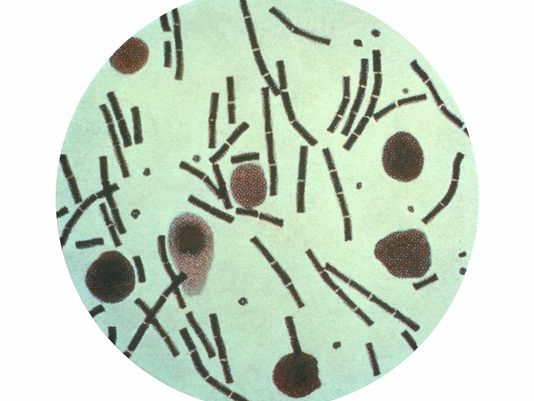Anthrax bacteria live primarily in inactive spores and are found naturally in the soil.
People can ingest or inhale spores, which can make the anthrax active.
Not all will be sickened when exposed to anthrax. However, when left untreated, anthrax illness can turn very serious or lead to death.
A blood culture test is used to confirm anthrax exposure.
The symptoms of anthrax depend on the type of infection and can take anywhere from 1 day to more than 2 months to appear. All types of anthrax have the potential, if untreated, to spread throughout the body and cause severe illness and even death.
Cutaneous anthrax symptoms can include:
- A group of small blisters or bumps that may itch
- A painless skin sore (ulcer) with a black center that appears after the small blisters or bumps
- Most often the sore will be on the face, neck, arms, or hands
- Swelling can occur around the sore
Inhalation anthrax symptoms can include:
- Fever and chills
- Chest discomfort
- Shortness of breath
- Confusion or dizziness
- Cough
- Nausea, vomiting, or stomach pains
- Headache
- Sweats (often drenching)
- Extreme tiredness
- Body aches

Gastrointestinal anthrax symptoms can include:
- Fever and chills
- Swelling of neck or neck glands
- Sore throat
- Painful swallowing
- Hoarseness
- Nausea and vomiting, especially bloody vomiting
- Diarrhea or bloody diarrhea
- Headache
- Flushing (red face) and red eyes
- Stomach pain
- Fainting
- Swelling of abdomen (stomach)
Injection anthrax symptoms can include:
- Fever and chills
- A group of small blisters or bumps that may itch, appearing where the drug was injected
- A painless skin sore with a black center that appears after the blisters or bumps
- Swelling around the sore
- Abscesses deep under the skin or in the muscle where the drug was injected
- Keep in mind
- Symptoms are similar to those of cutaneous anthrax, but injection anthrax can spread throughout the body faster and be harder to recognize and treat than cutaneous anthrax.
- Skin and injection site infections associated with injection drug use are common and do not necessarily mean the person has anthrax.
Anthrax entered the US national consciousness in 2001, when shortly after the 9/11 attacks, letters containing powdered anthrax arrived at news organizations and the offices of US senators. Twenty-two people were sickened and of those, five people died.
Sources: FBI Anthrax investigation; CDC, San Francisco Department of Public Health
